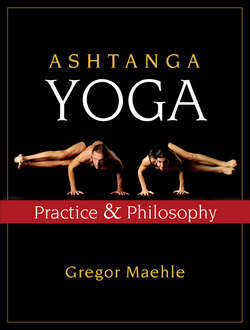Читать книгу Ashtanga Yoga - Gregor Maehle - Страница 230
На сайте Литреса книга снята с продажи.
Ardha Baddha Padma Pashimottanasana
ОглавлениеBOUND HALF LOTUS FORWARD BEND
Drishti Toes
Ardha Baddha Padma Pashimottanasana starts a new cycle of postures that combine forward bending with hip rotation. The Primary Series mainly consists of these two themes.
The postures are grounding and rooting, and they form the basis of the more exhilarating themes of backbending, leg-behind-head, and arm balances, which form the subject of the Intermediate and Advanced Series. From a yogic point of view the foundation must be properly prepared before we advance to a more complex practice.
Rotation Pattern
The next five postures establish the rotation pattern of the femur for the Primary Series. Sown here, this seed can eventually fructify in the performance of such complex postures as Mulabandhasana (the most extreme medial rotation) and Kandasana (the most extreme lateral rotation). The rotation pattern is as follows:
• Ardha Baddha Padma Pashimottanasana — medial rotation
• Triang Mukha Ekapada Pashimottanasana — lateral rotation
• Janushirshasana A — medial rotation
• Janushirshasana B — lateral rotation
• Janushirshasana C — medial rotation
ANATOMICAL FOCUS
The Paradox of Active Release
This is an important understanding that needs to be grasped in order to master the art of working deeply and harmoniously in all postures. Active release derives its effectiveness from the following principle: To enter a posture we use prime muscle groups that perform particular actions. Once in the posture, we must release those muscle groups and engage their antagonists to work harmoniously and more deeply into the posture.
For example, to go into a backbend we engage the trunk extensors (erector spinae, quadratus lumborum). Ultimately, however, these muscles limit backbending. They shorten the back and pinch the spinous processes of the vertebrae together. Once we have arrived in a backbend we need to release the trunk extensors and instead engage the trunk flexors (abdominal muscles). This lengthens the back, creates space between the spinous processes, and deepens the backbend.
The same principle is applied in hip rotations such as Ardha Baddha Padma Pashimottanasana and Baddha Konasana. We laterally rotate the femur to go into hip rotations, but when in the posture we release the lateral rotators by medially rotating the femur. This action takes us much deeper into the posture. In all forward bends such as Pashimottanasana we engage the hip flexors, particularly the psoas and rectus femoris, to go into the posture. Once the hip joint is flexed to about 160° we won’t be able to close the joint any farther because the bulging hip flexors are in the way. To illustrate, try out the following: Standing, bend the knee joint by merely contracting the hamstrings and the calf muscles. You will not be able to close the joint completely because the very muscles that perform the action also prevent its completion. Now use your hand to draw your heel to your buttock. At the same time resist your hand by gently attempting to straighten your leg. This slight leg extension, performed by the antagonists of the prime movers, will release and flatten out the leg flexors so that the joint can now be completely closed.
In the case of Pashimottanasana the principle of active release is applied by drawing the heels down into the floor. This engages the hamstrings and enables the psoas and rectus femoris to release. Once they are released the front of the hip joint can be fully closed and the forward bend completed.
This action does not mean the kneecaps will be released. The quadriceps, which pulls up the kneecaps, has four heads, rectus femoris being only one of them. If rectus femoris (the only two-joint muscle in the group) is released, the other three heads (vastus lateralis, medialis, and intermedius) can still pull up the kneecap and work to extend the leg.
These femur rotations refer to the action performed after one has arrived in the posture. To get into the posture the action is the opposite. When the rotation pattern is performed in this way, the more challenging postures in the series, such as Marichyasana D and Baddha Konasana, become easily accessible.
